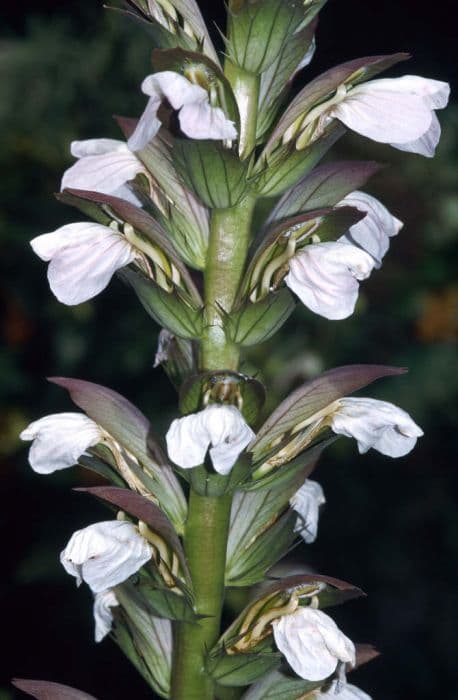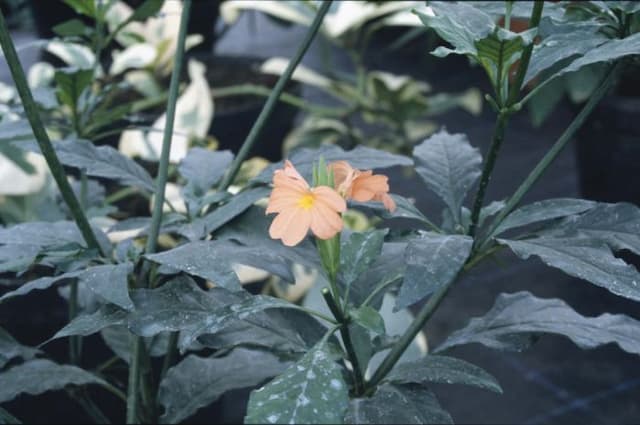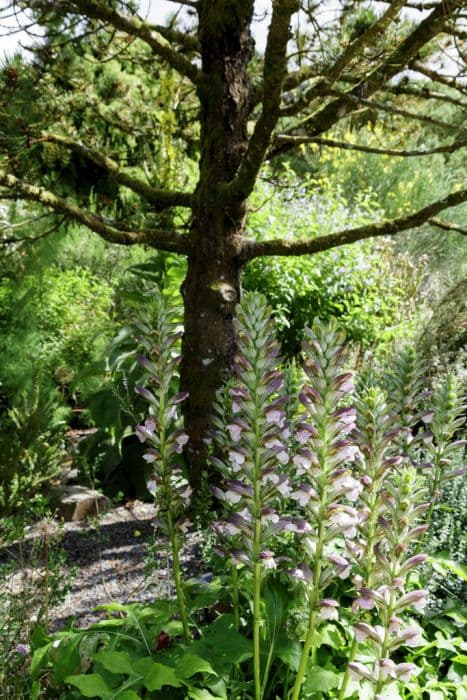Lollipop Plant Pachystachys lutea






ABOUT
The common name for Pachystachys lutea is the Lollipop Plant due to its unique flower arrangement that resembles lollipops. This tropical perennial is characterized by its striking appearance, featuring shiny green leaves and showy flower spikes. The leaves are large, elongated, and somewhat lance-shaped, providing a lush backdrop for the flower spikes. The most distinctive aspect of the Lollipop Plant is its inflorescence, which consists of a spike of bright yellow, overlapping bracts that form a cone-like structure. These bracts are what give the plant its common name, as they look like the wrapper of a lollipop. Nestled within these yellow bracts are the actual flowers, which are small, white, and tubular. They protrude from the bracts, creating a contrast of colors and a striking visual effect. The plant typically has a bushy appearance and often becomes more branched with age. The combination of its colorful bracts, flowers, and lush foliage make the Lollipop Plant a popular choice for adding a tropical flair to gardens and interior spaces. Its vibrant colors and unique floral arrangement make it an attractive specimen for ornamental display.
About this plant
 Names
NamesFamily
Acanthaceae.
Synonyms
Lollipop Plant, Golden Shrimp Plant, Yellow Shrimp Plant
Common names
Pachystachys coccinea, Justicia lutea.
 Toxicity
ToxicityTo humans
Pachystachys lutea, commonly known as Lollipop Plant, is not generally considered toxic to humans. It does not typically cause any severe symptoms of poisoning if ingested. However, as with any plant, individual sensitivities can vary, and it is always advisable to avoid ingesting plants not meant for human consumption as they may cause gastrointestinal discomfort or allergic reactions in sensitive individuals.
To pets
Lollipop Plant is not commonly listed as toxic to pets. However, it's still a good practice to prevent pets from ingesting this or any ornamental plant. Non-toxic plants can sometimes cause mild gastrointestinal upset if pets sample them.
 Characteristics
CharacteristicsLife cycle
Perennials
Foliage type
Evergreen
Color of leaves
Green
Flower color
Yellow
Height
4 feet (1.22 meters
Spread
2 feet (0.61 meters
Plant type
Shrub
Hardiness zones
11
Native area
Peru
Benefits
 General Benefits
General Benefits- Ornamental Value: Pachystachys lutea, commonly known as lollipop plant, features bright yellow bracts that resemble lollipops, adding visual interest to gardens.
- Attracts Pollinators: The flowers of the lollipop plant can attract hummingbirds and butterflies, promoting pollination in the garden.
- Tropical Aesthetics: With its lush green foliage and vibrant blooms, the lollipop plant contributes to a tropical look in landscaping designs.
- Easy to Grow: Lollipop plants are known for being relatively easy to care for, making them suitable for gardeners of all levels of experience.
- Container Gardening: Because of its moderate size, the lollipop plant is well-suited for container gardening, allowing for flexibility in placement and design.
- Shade Tolerance: The lollipop plant can tolerate partial shade, providing options for gardeners with less sunny spaces.
- Long Blooming Period: Lollipop plants have a long flowering season, which can provide color and interest in a garden for an extended period.
 Medical Properties
Medical PropertiesThis plant is not used for medical purposes.
 Air-purifying Qualities
Air-purifying QualitiesThis plant is not specifically known for air purifying qualities.
 Other Uses
Other Uses- Pachystachys lutea, commonly known as golden shrimp plant, can be used for educational purposes in botany classes to demonstrate plant structure and bract development.
- In regions where it is native, the golden shrimp plant is sometimes used in local religious and ritualistic decorations, incorporated into floral arrangements for ceremonies.
- The golden shrimp plant can be used in butterfly gardens to attract butterflies and hummingbirds, as its flowers are a source of nectar for these pollinators.
- As an ornamental plant, Pachystachys lutea's vibrant yellow bracts can be used in landscaping to create tropical-themed garden designs or for adding a splash of color.
- The contrasting green and yellow colors of the golden shrimp plant make it suitable for use in artistic photography to capture the brilliant color combination provided by nature.
- The dense foliage of the golden shrimp plant provides shelter for small fauna, like lizards and beneficial insects, creating a mini habitat within gardens.
- Its unique, shrimp-like blooms can be used in the floristry trade to create exotic and unusual floral arrangements.
- The plant's ability to grow relatively easily in containers makes it a good candidate for use in urban gardening projects on balconies and patios.
- In culinary arts, the colorful bracts of Pachystachys lutea can be used as a non-toxic garnish to decorate plates and platters for special occasions, though they are not edible.
- Golden shrimp plants can be used in theme parks and resort landscaping to provide a low-maintenance, tropical look that enhances the aesthetic appeal for tourists.
Interesting Facts
 Feng Shui
Feng ShuiPachystachys lutea, commonly known as Golden Shrimp Plant, can be used in Feng Shui for attracting wealth and abundance due to its golden-colored bracts. It is believed to add a positive yang energy to the home, which can stimulate prosperity. Place it in the southeast corner of the home or office for optimal effect.
 Zodiac Sign Compitability
Zodiac Sign CompitabilityThe Golden Shrimp Plant is not used in astrology practice.
 Plant Symbolism
Plant Symbolism- Tropical Exuberance: As a native plant to the warm regions of Central and South America, Pachystachys lutea, commonly known as the 'Golden Shrimp Plant', symbolizes the lushness and vibrancy of the tropics.
- Attractiveness: With its unique and striking yellow bracts that resemble shrimp, the Golden Shrimp Plant is often associated with beauty and the ability to attract attention in a garden setting.
- Hospitality: Because of its showy appearance, it is frequently used in ornamental displays and gardens, symbolizing a welcoming environment and generous hospitality.
- Warmth: The bright yellow color of its bracts is evocative of sunshine and warmth, making it a symbol of friendliness and the bright side of life.
- Adaptability: Given its ability to thrive in a variety of conditions as a houseplant, the Golden Shrimp Plant can symbolize adaptability and flexibility.
 Water
WaterThe Golden Shrimp Plant (Pachystachys lutea) prefers a consistently moist soil, so it should be watered once the top inch of soil feels dry to the touch. This might mean watering approximately once a week, but the frequency can vary based on environmental conditions. When watering, ensure you provide enough water to soak the soil thoroughly, and all excess water should be allowed to drain away to prevent root rot. An average amount might be two to four gallons every month, but this depends on the size of your plant and the pot. It is essential to reduce watering in the cooler months when plant growth is slower.
 Light
LightThe Golden Shrimp Plant thrives in bright, indirect light, avoiding the full, harsh sun especially in the heat of the afternoon. A spot near an east or west-facing window where it can receive a few hours of filtered sunlight is ideal. However, it can also tolerate a bit of morning direct sunlight, which can help promote flowering.
 Temperature
TemperatureThe Golden Shrimp Plant favors warm temperatures, ideally between 65 to 80 degrees Fahrenheit. It should not be exposed to temperatures below 50 degrees, as it is quite sensitive to cold. For optimal growth, keep it away from drafts and in a spot where the temperature is steady.
 Pruning
PruningPruning the Golden Shrimp Plant is essential to maintain its bushy appearance and encourage more blooms. Trim the plant back in the spring or early summer after the flowering cycle has ended. Pruning can be done as often as needed to remove dead flowers and leaves, which will also promote new growth.
 Cleaning
CleaningAs needed
 Soil
SoilThe best soil mix for Lollipop Plant, also known as Pachystachys lutea, should be rich, well-draining, and loamy. A mixture of peat, pine bark, and perlite or coarse sand in equal parts suits the plant well. The soil pH should be slightly acidic to neutral, ranging from 6.0 to 7.0.
 Repotting
RepottingLollipop Plant should be repotted every two to three years or when it has outgrown its current pot. The best time to repot is during the spring or early summer, which aligns with its active growing period.
 Humidity & Misting
Humidity & MistingLollipop Plant thrives in high humidity conditions, ideally between 60% to 70%. It benefits from regular misting or placement on a pebble tray with water to increase the surrounding moisture levels.
 Suitable locations
Suitable locationsIndoor
Place Lollipop Plant in bright, indirect light indoors.
Outdoor
Grow Lollipop Plant in partial shade when planted outside.
Hardiness zone
10-11 USDA
 Life cycle
Life cyclePachystachys lutea, commonly known as Lollipop Plant or Golden Shrimp Plant, starts its life as a seed, which upon germination in warm, moist soil, begins to sprout and develop roots and shoots. The seedling then grows into a young plant with leaves, and as it matures, it develops a woody stem and a bushy form. In its growth phase, the plant produces distinctive yellow bracts that resemble shrimps, with small white flowers emerging from them. After pollination, these flowers can produce seeds for the next generation if conditions are suitable. Under ideal conditions, Pachystachys lutea may flower multiple times a year. As a perennial, the plant can live for several years, going through repeated cycles of growth, flowering, and seed production.
 Propogation
PropogationPropogation time
Spring to Summer
Pachystachys lutea, commonly known as the Golden Shrimp Plant, is best propagated through stem cuttings. This method is popular due to its relative ease and high success rate. To propagate, select a healthy stem that is 4 to 6 inches (10 to 15 centimeters) long and has several leaf nodes. Cut just below a node with a clean, sharp pair of scissors or pruners. Remove the leaves from the lower half of the cutting, dip the cut end into rooting hormone powder to encourage root growth and plant in a well-draining potting mix. Keep the soil consistently moist, and provide bright, indirect sunlight. Roots typically develop within a few weeks, after which the new plants can be gradually acclimatized to their permanent positions.









